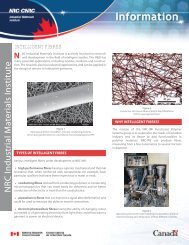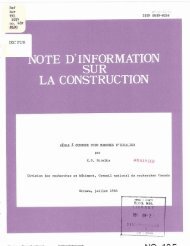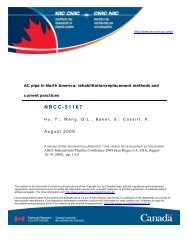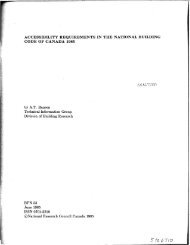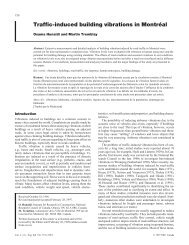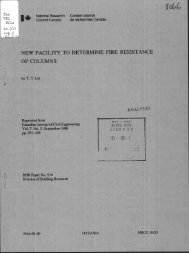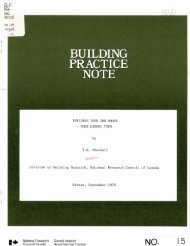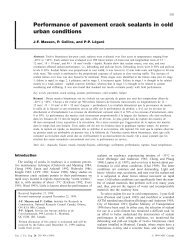Effect of Automatic Sprinkler Protection on Smoke Control Systems
Effect of Automatic Sprinkler Protection on Smoke Control Systems
Effect of Automatic Sprinkler Protection on Smoke Control Systems
You also want an ePaper? Increase the reach of your titles
YUMPU automatically turns print PDFs into web optimized ePapers that Google loves.
ecause each data point represents an early stage in thefires, such that the preceding histories <str<strong>on</strong>g>of</str<strong>on</strong>g> the crib fires weremore comparable than in the tests in the <strong>on</strong>e-story room.Again, the dashed diag<strong>on</strong>al line linking the unsprinklered tothe sprinklered-shielded points shows a str<strong>on</strong>g relati<strong>on</strong>shipbetween the spray density and the HRR <str<strong>on</strong>g>of</str<strong>on</strong>g>a fire,From the dashed line in Figure 3, it can be c<strong>on</strong>servativelyestimated that the HRR <str<strong>on</strong>g>of</str<strong>on</strong>g> the fires would be reducedto less than SO% <str<strong>on</strong>g>of</str<strong>on</strong>g> the n<strong>on</strong>sprinklered rate at an approximatedensity <str<strong>on</strong>g>of</str<strong>on</strong>g> 0.11 gprn!ft2 (4.5 Llmin·m 2 ). That HRR(for the 1,200-lb crib) was about 97S Btu/s (1,02S kW).For ihe 700-lb (318-kg) wood cribs in the Tower tests(Figure 4), the same SO% reducti<strong>on</strong> in HRR (to S70 Btu/s[600 kW]) occurred at a density <str<strong>on</strong>g>of</str<strong>on</strong>g> 0.13 gprn!ft 2 (S.3Llmin·m 2 ). It is noteworthy that the reduced, sustained heatrelease rates at comparable densities were in proporti<strong>on</strong> tothe mass <str<strong>on</strong>g>of</str<strong>on</strong>g> fuel within the shielded area.Two tests, <strong>on</strong>e in the <strong>on</strong>e-story room and the other inthe Tower, were c<strong>on</strong>ducted with the shielding removed sothat the sprinkler spray could extinguish the fires. In bothcases, the fires were extinguished in less than 12 minutes.The HRR values shown in Figures 3 and 4 for the unshieldedfires were peak values, measured just beforesprinklers activated, which then reduced to zero as the firewas extinguished.This leads to the questi<strong>on</strong> <str<strong>on</strong>g>of</str<strong>on</strong>g> what level <str<strong>on</strong>g>of</str<strong>on</strong>g> fire c<strong>on</strong>trolis expected from a typical sprinkler system designed to meetNFPA Standard 13 (NFPA 1991). That standard distinguishesbetween "fire c<strong>on</strong>trol" and "fire suppressi<strong>on</strong>" andrecognizes that the sprinkler system is deemed to haveachieved .fire c<strong>on</strong>trol if it limits the size <str<strong>on</strong>g>of</str<strong>on</strong>g> the fire, decreasesthe HRR, and c<strong>on</strong>trols ceiling temperatures. The limits<strong>on</strong> the size <str<strong>on</strong>g>of</str<strong>on</strong>g> the fire (area) are not stated but clearly willbe some fracti<strong>on</strong> <str<strong>on</strong>g>of</str<strong>on</strong>g> the "design area," which is the areaprotected by the maximum number <str<strong>on</strong>g>of</str<strong>on</strong>g> sprinklers permitted(by the NFPA Standard 13 design criteria) to open. Thec<strong>on</strong>trol over ceiling temperatures also relates to the designarea: combusti<strong>on</strong> gases must be cooled within its boundaryso as not to activate sprinklers outside the design area. Theintended degree <str<strong>on</strong>g>of</str<strong>on</strong>g> c<strong>on</strong>trol over the heat release rate canthen be inferred: the HRR must be small enough that gastemperatures higher than the sprinkler temperature rating d<strong>on</strong>ot spread outside the design area.These experiments dem<strong>on</strong>strated that sprinklers substantiallyreduced the heat release rates <str<strong>on</strong>g>of</str<strong>on</strong>g> the wood crib fires,even though they were operating at lower spray densitiesthan would be normal for such fuel loads. They alsodem<strong>on</strong>strated that the magnitude <str<strong>on</strong>g>of</str<strong>on</strong>g> the heat release ratedepends <strong>on</strong> the amount <str<strong>on</strong>g>of</str<strong>on</strong>g> fuel present within the shieldedarea and that the fuel within that area will c<strong>on</strong>tinue burninguntil it is mostly c<strong>on</strong>sumed. Knowledge <str<strong>on</strong>g>of</str<strong>on</strong>g> the maximumarea <str<strong>on</strong>g>of</str<strong>on</strong>g> shielding possible in a sprinklered building (excludinga gross error in the system design) and the weight andtype <str<strong>on</strong>g>of</str<strong>on</strong>g> fuel likely to be held within the shielded area couldbe used to estimate the maximum beat release in a sprinklered,shielded fire.It was menti<strong>on</strong>ed earlier that the statistical review d<strong>on</strong>e500by Morgan and Hansell (198S) c<strong>on</strong>cluded that fires in asprinklered <str<strong>on</strong>g>of</str<strong>on</strong>g>fice building were likely to be between 28Sand 2,8SO Btu/s (300 and 3,000 kW), with a higher probability<str<strong>on</strong>g>of</str<strong>on</strong>g> occurrence <str<strong>on</strong>g>of</str<strong>on</strong>g> fires in the low end <str<strong>on</strong>g>of</str<strong>on</strong>g> the range.The results <str<strong>on</strong>g>of</str<strong>on</strong>g> this series <str<strong>on</strong>g>of</str<strong>on</strong>g> full-scale tests indicate thatshielded fires with heat release rates as high as 97S Btu/s(1,02S kW) are possible, depending <strong>on</strong> the amount <str<strong>on</strong>g>of</str<strong>on</strong>g> fueland the sprinkler density. The wood cribs in these tests,however, particularly in the <strong>on</strong>e-story room, represented asubstantial fuel mass arranged in an ideal burning formati<strong>on</strong>.Yet, <strong>on</strong>ly two sprinklers, operating at minimumdensities appropriate for their listing, kept the HRR below9SO Btu/s (1,000 kW). These measurements suggest thatshielded fires in sprinklered <str<strong>on</strong>g>of</str<strong>on</strong>g>fice buildings are likely tohave heat release rates below 9SO Btu/s (1,000 kW). Theresults also imply that for an occupancy in which shieldedfires are a possibility, design densities higher than theminimum recommended values for unshielded c<strong>on</strong>diti<strong>on</strong>swould be beneficial.<str<strong>on</strong>g>Effect</str<strong>on</strong>g>s <str<strong>on</strong>g>of</str<strong>on</strong>g> <str<strong>on</strong>g>Sprinkler</str<strong>on</strong>g>s <strong>on</strong> Heat Fluxto SurroundingsFigure S shows the intensity <str<strong>on</strong>g>of</str<strong>on</strong>g> radiant heat energy inthe <strong>on</strong>e-story test room, approximately 6.5 ft (2 m) fromthe wood crib, at mid-height <str<strong>on</strong>g>of</str<strong>on</strong>g> the room, measured atdifferent spray densities. In additi<strong>on</strong> to removing c<strong>on</strong>vectiveheat energy from the hot gases given <str<strong>on</strong>g>of</str<strong>on</strong>g>f by the fire,sprinklers reduce fire severity by absorbing radiant beatenergy in the fire compartment. In an unsprinklered fire,heat radiates from the visible flames and from the hot gaslayer that develops in the upper porti<strong>on</strong> <str<strong>on</strong>g>of</str<strong>on</strong>g> the room. Thisradiant heat reflects from surrounding surfaces back to the'¢:~1.41.21.0 -l! o.s -"' ,;=li: 0.6'a!u:I:0.40.20...,.,0.0 '0.00Figure 5<str<strong>on</strong>g>Sprinkler</str<strong>on</strong>g> spray density Lpm/ml2 3 4 s 6 7 8' ' ' ' '1614- 12.,~..,.1 Me10~8 ,;=li:6 'a!:!I ...y·' ' '4y ' y,Yy' ' '2''• 0o.os 0.10 O.lS 0.20<str<strong>on</strong>g>Sprinkler</str<strong>on</strong>g> spray density USgpmlft'Heat flux at mid-height <strong>on</strong> the south wall <str<strong>on</strong>g>of</str<strong>on</strong>g>the <strong>on</strong>e-story test room versus sprinkler spraydensity.ASH RAE Transacti<strong>on</strong>s: Research... ~




